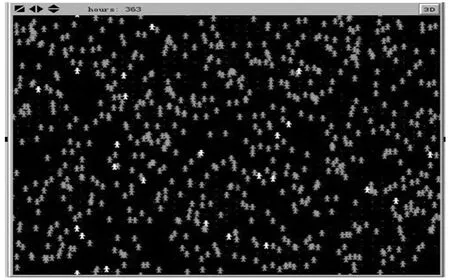The Simulation of the Influenza Transmission Dynamics in Tropical Area and Subtropical Area in East Asia
YANG Gong-li
(College of Automation Engineering,Qingdao University,Qingdao Shandong 266071,China)
0 Introduction
Influenza is a major cause of acute respiratory disease among humans and is associated with global pandemics and annual epidemics.The influenza virus have three types,influenza A,B,and C.Type A can infect birds and mammals,and is the most virulent in humans.The type A virus has been confirmed subtypes in humans include H1N1,H2N2,H3N3,H5N1,and H9N2[1].Type B virus can cause milder epidemics in some ways[2].Type C virus can infect human,dogs,and pigs,but cannot cause epidemics in humans[3].The world health organization(WHO)statistics shows that the flu can influence 5%-15%of the population around the world every year;there are 3 million to 5 million severe cases including 500,000 people dead[4].
The research of influenza epidemiological characteristics shows that influenza disease has obvious seasonal patterns,and different seasonal epidemic in temporaland tropicalareas.In temperate zone,the transmission peaks during winter(December to February).The reason for the winter peak is that:the low humidity and low temperature benefit the survival and the spread of the virus[5].However,in tropical area,in addition to the winter epidemic peak,there is a small epidemic peak during summer(July to September),hence transmission of influenza virus in tropical area has a semiannual pattern[6].At present,the cause of the summer peak is still unclear.
The influenza transmission can be considered as a complex system.In this paper,we use complex systems method to model and simulate influenza transmission.In order to explain the flu epidemic peak,we establish a dynamic model of the influenza based on the agent based modeling (ABM)and simulate the transmission process using ABM simulation tool Netlogo.
1 Merhods
Agent-based models (ABM)have been widely used in ecology,social science,politics,economics and molecular biology[1].The advantage of ABM is that individual entities can interact with another or external environment.The paper will use it to build an ABM model of influenza which including agents interaction with the environment.Our ABM influenza transmission model is a multi-path transmission model which is easy to analyze the importance of the influenza transmission path in different seasons and can be better used for evaluating the effectiveness of proposed control strategies.
The model was built in the simulation platform of Netlogo.It is created by the Northwestern University and is a multi-agent modeling development platform.The simulation model is made of turtles,patches and the observers.In the paper,each patch is defined as a single space(such as a room or a region in the real world).The turtle represents people,and the people can move freely in the space.
2 The ABM model
Flu viruses spread through many paths.Infected person discharges influenza virus into the environment by coughing or sneezing.The virus will suspend in the air or gradually fell on the surface.The amount of the virusdeterminesthe transmission rates,and the transmission to susceptible host.The infection rate influenced by climate factors is quite different in the two routes.Therefore,the model considers the amount of the virus in the air and fomite along with the infection rate in different climate.
We present the ABM model with the following assumptions:
(1)The total population is constant;
(2)The model does not consider the mortality rate and the age,because the two factors have no effect on the flu dynamic.
(3)The influenza virus spread in the current patch space,while not spread to nearby patch.
(4)Patients release the same amount of virus to the patch every unit time.
We create two kinds of agents including the persons and the virus.The persons include three states like “suspect”, “infected”,and“recovered”.The virus is divided into airborne virus and fomite-surface virus.The different colors in the simulation interface represent three states of person;susceptible people (white),infection (red,pink),survivors (green),which red is infected through the air,the pink is infected by fomite.The persons and the virus are distributed randomly in the space grid (patch)in Netlogo.The person can move randomly in the environment,constantly changing their position,moving in a random direction (0-40 of patch distance).This simulation model include 1000 people(turtle)and 1600 space(40*40).Any space can be represented by the coordinates(x,y).

Figure1 The virtual world in the netlogo
During the setup peri od,the system produces 1000 persons and randomly distribute in the patch.10 persons are set to the state of infected,the state of the other persons are susceptible.All persons(i)have been set the infection time(the time length of being recovered from infection),the immune time(the immunity time length),the infection momentt(infection moment for susceptible people become infected),and the recovery momentt(infection moment for infected people become recovered)(All the parameters are based on literatures).
The model also considers the factors of seasonal climate.Shanman reanalysis the animal experiment results of Lowen,shows that absolute humidity (AH)is more important than the relative humidity (RH)and temperature on the flu epidemic dynamics reflected by the climate factors[7].Therefore,we only consider the absolute humidity on effect the influenza transmission capacity.During the summer,when the absolute humidity(AH)is greater than threshold value,the aerosol path will be contained.So we assume that the spread ability of the influenza virus through the fomite does not vary with seasonal climate in the model.
Results and discussion

Figure 2 The fluctuations of the infected number
We implemented the influenza transmission ABM model in Netlogo platform,Figure 2 shows the fluctuations of the infected number over time.Figure 2(a)does not include the fomite route in the summer.Figure 2 (b) includes the fomite transmission path in the summer.Results show that when the ABM model does not include the fomite route,the summer will not form the flu wave peak and only one peak fluctuation in one year;when model including fomite transmission path,it will form one small peak in summer.
The spread of influenza is a complex system.We need to understand the influenza transmission from multi-disciplinary and multi-angle.This paper simplifies some problems in the reality,such as the factor that influenza viruses spread by shaking hands is ignored as well as the model don't consider the incubation period of the flu,whereas the ABM model focuses on the crucial factors in the process of transmission,and analyses the dynamic pattern of influenza disease.
We built the ABM model of influenza transmission from a new point of view.The model will explain the reason of the subtropical bimodal phenomena of the flu spread.Previous influenza transmission model only establish one path and analysis its role.In the paper we established two kinds of influenza transmission path in the influenza ABM model.At the same time,the seasonal effect is joined in influenza transmission path.This model can test the relative significant degree of the two different influenza transmission.
[1]Li S.Environmentally mediated transmission models for influenza and the relationships with meteorological indices[D].The University of Michigan,2011.
[2]Hay A,Gregory V,Douglas A,Lin Y.The evolution of human influenza viruses[J].Philos Trans R Soc Lond B Biol Sci.2001,356(1416):1861-1870.
[3]Matsuzaki YSK,Mizuta K,Tsuchiya E,Muraki Y,Hongo S,Suzuki H,Nakamura K.Antigenic and genetic characterization of influenza C viruses which caused two outbreaks in Yamagata City,Japan,in 1996 and 1998 [J].J Clin Microbiol.2002,40(2):422-431.
[4]Shrestha S FB,Weinberger D.M.et al.Identifying the interaction between influenza and pneumococcal pneumonia using incidence data[J].Science Translational Medicine.2013,5(191):184-191.
[5]Lowen A,Palese P.Transmission of influenza virus in temperate zones is predominantly by aerosol,in the tropics by contactA hypothesis[J].PLoS Currents.2009,1:RRN1002.
[6]Moura FE PA,Siqueira MM.Seasonality of influenza in the tropics:a distinct pattern in northeastern Brazil[J].American Journal of Tropical Medicine and Hygiene.2009,81:180-183.
[7]Jeffrey mk.absolute humidity modulates influenza survival,transmission,and seasonality[J].PNAS.2009,109:3243-3248.
- 科技视界的其它文章
- 浅谈英语中定冠词的几种用法

